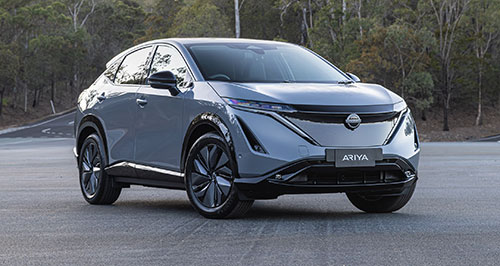NISSAN has finally confirmed when the Ariya will go on sale in Australia, the battery electric medium SUV arriving in the second half of 2025.
The company claims to be better placed than most to address the incoming New Vehicle Efficiency Standard (NVES) despite strong year-to-date sales growth for thirsty models like the Navara ute (4x2 up 67.8 per cent, 4x4 up 40.8 per cent) and Patrol off-roader (up 21.4 per cent).
Nissan currently also has just two hybrids (with relatively low penetration compared with the likes of Toyota) plus one slow-selling battery electric model (until the Ariya arrives).
Announcing Ariya launch timing at a media briefing in Melbourne this week, Nissan Oceania vice president and managing director Andrew Humberstone said the long-awaited model “will have a comprehensive line-up, including different specifications and battery sizes available for customers”.
Mr Humberstone also suggested that the third-generation Leaf electric car – previewed by the 2021 Chill-Out concept with the production version to be revealed between now and March 2027 – is locked in for Australia and dropped heavy hints that Nissan’s successor to the NP300/D23 Navara will eventually deploy Nissan’s solid-state battery technology which is due to hit the market before the end of this decade.
Ariya details for this market remain thin on the ground but a 2026 model year update – potentially a major as-yet unrevealed facelift – is likely given the model originally went on sale in 2022 overseas, after several pandemic-related delays.
Mid-size electric SUV competitors to the Ariya include the Toyota bZ4X and Subaru Solterra twins, VW ID. 4, Skoda Enyaq, Kia EV5 and Tesla Model Y, all of which play in the $55K-$75K price range.
Three mainstream Ariya trim levels are offered elsewhere, with single-motor front-wheel drive and dual-motor all-wheel drive plus 63kWh and 87kWh battery packs capable of covering up to 530km on a single charge when combining the 178kW/300Nm single motor and larger battery size (output drops to 160kW with the smaller battery).
Given Australia’s predilection for performance cars, the Nismo version sounds likely with its 320kW/600Nm outputs and enhanced suspension as range flagship above the 290kW/600Nm dual-motor, big battery version.
All these specs could change for the expected Ariya update that will be sold in Australia, with battery, drivetrain and aerodynamic tweaks potentially bringing greater performance and range as has been the case with most competitors that were similarly held back from this market until upgraded versions became available.
Mr Humberstone pointed out that the Ariya has received several accolades overseas, most recently picking up British publication Autotrader’s 2024 “best car for long distances” award, outgunning the hybrid Volvo XC60 and battery electric BMW iX3.
With the Ariya, backed by other electrified variants available or in the pipeline, Mr Humberstone said he was sure Nissan would be more than capable of meeting NVES targets but reiterated his stance that Australian Design Rules presented hurdles to the introduction of some products.
“I think in terms of product technology, future product line-up that we have, we're ready for that (NVES) and significantly better position than some of our competitors,” Mr Humberstone told GoAuto.
“We can move as quickly as the government wants us to move,” he said, referring to Nissan’s efforts to lobby the federal government for reforms to Australian Design Rules (ADR) that would streamline the type approval process when introducing new vehicles for this market – a position shared with alliance partner Mitsubishi and now officially embraced by the Federal Chamber of Automotive Industries (FCAI).
“That's why we've raised the question around ADR, we can move even quicker if you want us to,” he said.
“We also know that customers in this market love their lifestyle experience, which is around their off-roading, their camping, their country lifestyle, so we will manage those in parallel, because we have a commercial business narrative and a customer demand, and we have a government narrative which serves also our new technology and solid-state battery and all of these things that we've we're driving on a more global level.
”We can run these things parallel, actually, I think, very efficiently. And I'm very optimistic on how we can do that. So we just need clarity around regulation, and what the request is.”

























Facebook Twitter Instagram